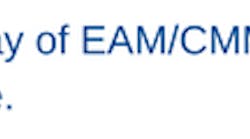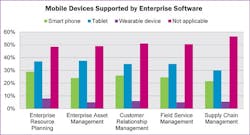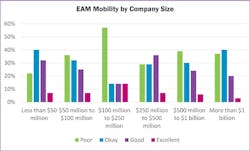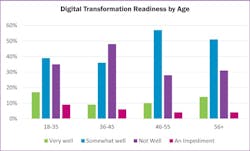Successful industrial organizations actively benchmark and study workforce performance, development, and satisfaction. Research findings often lead to organizational, process, and technology improvements.
This year, mobility has been a prominent research topic. Several recently completed studies answer whether or how effective mobility can alleviate operational or human resource challenges in industrial maintenance organizations.
Hidden opportunities and concerning tendencies were found. Will young maintenance candidates, programmed to expect all things mobile, adapt to an environment dependent on stationary workstations? How does a company’s size correlate to mobility adoption? What types of efficiency gains can be expected?
Companies operating with inadequate tool sets are bound to struggle with operational inefficiencies, but their challenges also extend to recruiting and retention. In particular, maintenance organizations dealing with aging workforces and similarly aging equipment need to find and take every opportunity to optimize performance, while attracting and retaining top talent. The recent research on mobility is helping to point the way.
The case for mobility
Most of the maintenance workforce is mobile by nature. On any given day, technicians and other skilled labor will move from equipment to equipment, in and out of storerooms, and sometimes from site to site. They may walk thousands of steps throughout and around a plant, or drive to assets distributed over great distances.
With this in mind, it is anyone’s guess why companies would not offer, let alone encourage, the use of mobile devices in maintenance and field service organizations. Unfortunately, this barrier is not uncommon.
CMMS Score and Maintenance Connection recently partnered to develop new research on maintenance software. Their findings, published in May in the 2017 State of CMMS Report, include two salient points on mobility. The first is that 80% of organizations that actively use mobile CMMS report strong improvements to labor efficiency. Secondly, 40% of organizations still don’t use a mobile CMMS. The latter, however, is a stark improvement over last year’s study (2016 State of CMMS Report), when 75% didn’t use a mobile CMMS. The benefits attributed to mobility are evidently getting noticed.
Another recent study, conducted by Plant Services in partnership with enterprise software vendor IFS, looked specifically at mobility trends. The findings were published in the February 2017 Plant Services Special Report, Mobility can drive asset management success (if IT lets you).
In this study, 64.2% of respondents said their organization allows the use of mobile devices for maintenance-related work, 14.7% said no but expect to within two years, and a surprising 21.1% said no and have no plans to do so. Further, asset management (EAM/CMMS) software is behind the curve in benefitting from the trend towards mobility. “When asked if they were using mobile devices to access their EAM/CMMS, almost 58% of respondents said no,” says the report.
For the fortunate minority accessing EAM/CMMS via mobile devices, the six most commonly used functions are related to increasing worker productivity:
- Work instructions (34.7%)
- Planning and scheduling (32.6%)
- Reporting (30.5%)
- Route management (28.4%)
- Alerts (28.4%)
- Repairs (25.3%)
Mobile devices are uniquely suited to these processes. They provide access to and reporting on critical information in real time, from any location. They allow more complete and accurate records to be captured on the spot, rather than hours later at a fixed workstation after time takes its toll on the memory. Automated routings, notification of emergent and emergency work, and immediate access to diagnostic, inventory, and other crucial data increase wrench time and uptime, and optimize maintenance performance.
IFS recently conducted its own study of mobile experiences encompassing enterprise resource planning (ERP), enterprise asset management (EAM), field service management (FSM), customer relationship management (CRM), and supply chain management (SCM) software. Its conclusions are published in the May 2017 report titled Enterprise Software Mobility and Digital Transformation.
Figure 1. Mobile devices supported by enterprise software (Source: IFS)
The IFS research found that only 31% of respondents regularly accessed their enterprise software using a mobile device, and only 17% of respondents could access the entirety of an enterprise software suite with a touch-screen device like a tablet.
The heaviest mobile users were found to be over 55 years old, followed by respondents between the ages of 18-35. The least likely to access enterprise software on a mobile device are 36-55 years of age. “This may be because the ways that senior managers, supervisors, and those involved in analytics and decision-making use enterprise software are different,” the report suggests. It notes that policies barring personal devices may restrict mobile access to more senior personnel, who use company-issued tablets that allow data consumption but few transaction options.
Company size also influences the adoption of mobile technology, the IFS study found. Small and enterprise-level organizations report a greater degree of enterprise mobility than the middle market companies with revenues between $100 million and $1 billion. Middle market organizations have many of the complexities of enterprise-sized companies, but may lack sufficient capital or IT resources to invest in mobile solutions.
Figure 2. EAM and FSM mobility by company size (Source: IFS)
Companies that fail to entertain mobility may to miss out on new revenue opportunities. For example, to be successful in aftermarket services, “companies will need to ensure their enterprise software platform can be extended to encompass business models including field service, depot repair, warranty work, maintenance, repair and overhaul, and other processes associated with aftermarket service,” says the IFS report.
Tying in human element
Company leaders would be remiss if they failed to recognize the importance of mobility. The Plant Services study respondents were asked what barriers and challenges they think their business will need to overcome in order to achieve the kind of growth they would like to see, and four are human resource related:
- Difficulty in recruiting skilled workers: 49.5%
- Difficulty in retaining the best staff: 33.3%
- Lack of ambition and willingness from colleagues: 16.1%
- Language and cultural barriers: 12.9%
Similarly, a lack of up-to-date technology was noted by 20.4% of the respondents as a barrier or challenge that their business needs to overcome. Better mobility tools have the potential to alleviate each of these concerns.
Figure 3. Digital transformation readiness by age (Source: IFS)
In fact, companies that embrace digital transformations are more likely to attract and retain the best talent. According to the 2015 MIT Sloan Management Review study titled Strategy, Not Technology, Drives Digital Transformation, 85% of Millennials and 75% of Baby Boomers said they saw it as important to work for a digital leader.
The common thread among all of the research is that while maintenance workforces benefit greatly from proper mobility and usability, companies have been slow to act on this knowledge. With studies like these, improvement rates should begin to accelerate.






